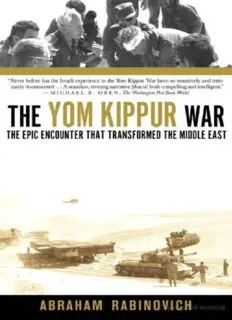
The yom kippur war : the epic encounter that transformed the middle east PDF
Preview The yom kippur war : the epic encounter that transformed the middle east
Table of Contents Title Page Dedication Epigraph MAPS PREFACE PROLOGUE One - FOOTPRINTS IN THE SAND Two - THE MAN IN THE PEASANT ROBE Three - DOVECOTE Four - BADR Five - ILLUSIONS Six - SUMMER LULL Seven - A ROYAL VISIT Eight - SWORD FROM THE SCABBARD Nine - COUNTDOWN Ten - YOM KIPPUR MORNING Eleven - THE CROSSING Twelve - THE HUMBLING OF THE TANK Thirteen - MOBILIZATION Fourteen - SYRIAN BREAKTHROUGH Fifteen - DARKEST AT DAWN Sixteen - THE FALL OF THE SOUTHERN GOLAN Seventeen - THE BEANSTALK Eighteen - THE BATTLE FOR NAFAKH Nineteen - CUT OFF Twenty - HAND ON THE TILLER Twenty-one - FAILED COUNTERATTACK Twenty-two - BOMB DAMASCUS Twenty-three - TOUCHING BOTTOM Twenty-four - GOLAN COUNTERATTACK Twenty-five - IRAQI INTERVENTION Twenty-six - POWERS THAT BE Twenty-seven - ISRAEL SEEKS A CEASE-FIRE Twenty-eight - DECISION TO CROSS Twenty-nine - STOUTHEARTED MEN Thirty - THE CHINESE FARM Thirty-one - THE BRIDGES Thirty-two - CROSSING INTO AFRICA Thirty-three - BREAKOUT Thirty-four - KISSINGER TO THE FORE Thirty-five - CEASE-FIRE Thirty-six - SUEZ CITY Thirty-seven - NUCLEAR ALERT Thirty-eight - AFTERMATH NOTES A SELECTED BIBLIOGRAPHY About the Author Also by ABRAHAM RABINOVICH Copyright Page TO MICHAL AND GUY, DANA AND ELAN, YARDEN, DAVID, AND BENNO On Rosh Hashana it is written and on the day of the fast of Kippur it is sealed . . . who shall live and who shall die, . . . who by water and who by fire, who by the sword. . . . —FROM THE YOM KIPPUR PRAYER BOOK MAPS Israel and Its Neighbors xiv The Suez Front 2 Maximum Syrian Advance 143 The Battle for Nafakh 195 The Israeli Enclave 308 The Israeli Crossing of the Suez Canal 368 Cease-fire Lines on the Egyptian Front 469 PREFACE ON YOM KIPPUR AFTERNOON, 1973, Israel was caught by a surprise attack on two fronts with the bulk of its army still unmobilized. When the fighting ended less than three weeks later, its army was on the roads to the Egyptian and Syrian capitals in one of the most remarkable turnabouts in military history. Israel emerged from the war, however, more chastened than triumphant. Much has been published about the Yom Kippur War, but there has been lacking a narrative that tells the extraordinary story with the inclusive sweep it deserves. The passage of time has eased censorship restrictions— most notably in the release of the findings of an Israeli inquiry commission into the war—and permitted publication of valuable memoirs and analyses. I have availed myself of this material and the human dimension provided by 130 interviews. I covered the war as a reporter for the Jerusalem Post. On its fifth day, I reached the northern part of the Golan Heights together with a colleague, Joe Treen of Newsday. The battlefield was eerily quiet and the fatigued soldiers we encountered could tell us little of what had happened. Unknown to us, the biggest tank battle since the Second World War had just ended. A vastly outnumbered Israeli force had stopped the Syrian army, which attacked with more than one thousand tanks. The last of the Syrians had been driven back only hours before after desperate fighting, and Israeli forces would the next morning launch a counterattack towards Damascus. The counterattack was to have been carried out this day, but entire battalions were falling asleep whenever their tanks stopped moving. The quiet we had stumbled into was that of two exhausted armies gathering strength for the next round. I would learn much of this only twenty years later when I researched an article on the battle. Deeper familiarity with the subject made it clear that although I thought myself well informed about the war, what I knew were only disconnected episodes in a fuzzy matrix. Missing was the epic quality that could only be grasped by understanding both the decision-making processes of the high commands and the flow of events on the battlefield itself. I have spent the
